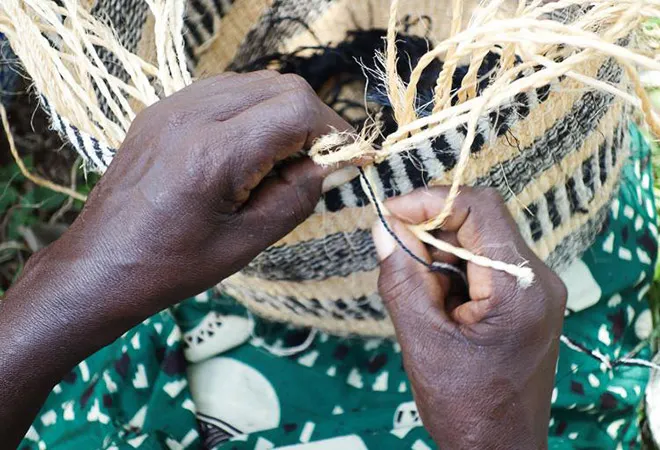
When I started selling Okapu bags, many young people did not welcome the idea of replacing their everyday imported handbag with a ‘kyondo,’which they had only seeing their mothers and grandmothers carrying. They did not think of them as fashionable. A kyondo, as it is locally known in Kenya, is a traditional basket specially woven by the Kamba tribe women, and uses the fibres of the sisal plant, which is sometimes mixed with upscaled/cotton yarn. Kyondos are eco-friendly and at Okapu, we are striving to shift the perception around them; one of our strategies is to ‘modernise’ the kyondo by using trendy styles and accessories so that the traditional design appeals to handbag buyers both in Kenya and the larger world. One of our biggest concerns at Okapu, however, is that all our weavers are above 40 years old. Unfortunately, the skill of bag making was not taught to the youth, who are likely seeking white-collar jobs. This begs the question: will kyondos exist in twenty-something years?
The sustainability of individuals and societies, as defined by the UN, is dependent on the harmonisation of environmental protection, economic growth, and social inclusion. Culture has been identified as a pillar of social inclusion, and answers the question of who exactly sustainable development was meant for, and asks if its way of life is being considered in our strategies. Okapu provides a practical example of the relationship between culture and development: through our work, the group of women we work with in rural Mwingi are able to earn an income for every bag they weave. Moreover, the weaving of the kyondo is part and parcel of who they are, as they were taught this skill when they were children.
Culture has been identified as a pillar of social inclusion, and answers the question of who exactly sustainable development was meant for, and asks if its way of life is being considered in our strategies
It is unfortunate that many Africans, despite our rich cultures and heritage, continue to live below the poverty line. The African Development Bank has predicted that more than 260 million young people will lack an economic stake in the system by 2025.While it is great to see that a lot of effort is being made to solve this alarming problem globally – especially by supporting entrepreneurs and strengthening industrialisation across Africa -- there is not enough emphasis on the development of cultural skills among the youth. As a pedagogical subject, arts and crafts is neglected; thus, skills like basket weaving have disappeared from our curriculum. Instead, our education system is mostly centred on disbursing information that will lead to white-collar work - it is therefore assumed that teaching of such skills is not necessary. This is a great misconception.
The Indian government provides a good counter-example, by providing subsidies to craftsmen to ensure that certain craft skills (like carpet making in Agra) are not forgotten. This is an inordinate initiative but it gives an indication that the demand for that industry’s goods is not enough to sustain itself without government intervention. Is the demand lacking because not enough people know about the goods or are they just too expensive for the majority?
Typically crafted/ handmade goods fetch higher prices than mass-produced items, but handmade clothes and accessories can barely compete with fast fashion in terms of price and production turnaround. Consumers of fast fashion enjoy variety through the year at a low price; thanks to this rate of production, fashion consumption in the West has tripled since the 1960s. However, fast fashion is the second highest polluter as it uses non-biodegradable materials.
Buying less is not going to catch on as fast as we need it to, especially with the rising popularity of social media
Many environmentalists are working to combat this: they encourage buying less, buying items made from sustainable materials, and holding those who sell fashion accountable. However, based on my observations, buying less is not going to catch on as fast as we need it to, especially with the rising popularity of social media. While fast fashion pollution is still not a big issue in Africa, this time offers a unique position to avoid some of the mistakes incurred by others. Most of us still buy second hand fashion items that were supposedly donated from the West, or were rejects from their factories. However, we cannot ignore the fact that fast fashion is gradually taking root in our societies too, with many foreign-owned fashion brands. We need to look back at how our ancestors made their clothes and accessories, and most importantly, understand how they produced these objects sustainably. For example, banana leaves were once used to make very good fabrics. Kenya is among the world's foremost banana leaf production producers, (approximately 1.1 million metric tons are produced a year), yet I have not seen not one fashion brand using this material. Going forward, it is imperative that we think about sustainability when we think of our modern needs. An important piece of these systems is ensuring that these skills are adequately transferred from one generation to the next, to ensure a strong and durable labour force.
The views expressed above belong to the author(s). ORF research and analyses now available on Telegram! Click here to access our curated content — blogs, longforms and interviews.




 PREV
PREV


